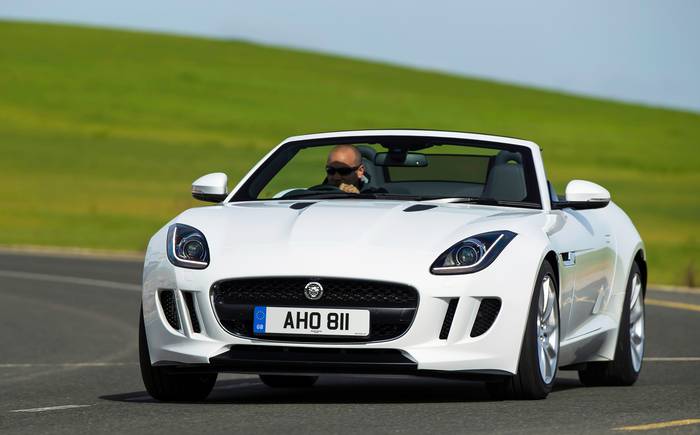The Clarkson review: Jaguar F-type S (2013)
It's a hard life

LEGEND HAS it that when Frank Sinatra first clapped eyes on the then new E-type Jaguar at the New York motor show, he said, “I want that car. And I want it now.” The E-type had that kind of effect. Pedants were saying that the actual cars you could buy would not achieve the claimed top speed of 150mph, and back then everyone knew that the “Made in England” tag was another way of saying you’d arrive everywhere in a cloud of oily steam.
But the E-type was so bite-the-back-of-your-hand pretty that grown men lost their capacity for reason. They simply didn’t care how much it cost or how uncomfortable it might be or even if it did only six miles to the gallon . . . of myrrh. They had to have one.
Search for and buy a Jaguar F-type on driving.co.uk
And now history has repeated itself with the F-type. I’d seen early spy shots of this car, and I’d even spotted camouflaged mules being tested around the Cotswolds. And I’d got it into my head that it would be nothing more than an XK that had been boiled for a bit too long in the washing machine. I was very, very wrong.
It is a spectacularly good-looking car. The bulge of the wheelarches, the length of the bonnet, the flatness of the boot lid, the angle of the rear window — every single little thing is completely flawless. There must have been a temptation to fit a retro nod to the E-type. But apart from the slender rear-light clusters, there’s not one. So it’s perfect and it’s modern, and as I stood there gawping, I had a Frank Sinatra moment. I have to have this car. And I have to have it now. A few days later, however, when the test drive was over, I was starting to have some doubts . . .
When I was growing up, Jags were driven by people who had sheepskin car coats and they were very soft to sit in. They were also very quiet. This is because they’d usually broken down. All over the world they were known for these two qualities: quietness and comfort.
The F-type offers neither of those things. I tested the mid-range, V6-engined S version and it is a bite-sized parcel of barely controlled fury; the angriest, most brutal and loudest car I’ve encountered in some time. Then I discovered a button on the dash that makes the exhausts louder still.
Even on the overrun, as you cruise up to a junction, a clever system of flaps causes the back boxes to spit and crackle and bang. It sounds like distant artillery fire. Then you pull out from the junction and press the accelerator and, whoa, now it feels as if you have actually become an artillery shell.
God knows what the 5-litre V8 is like because the firepower from the 3-litre V6 is plenty savage enough. One minute you’re balancing the throttle against the interruption of the traction control system, and the next you’re in Arbroath, doing a million, there’s blood streaming from your shattered eardrums and your hair’s on fire. Exciting doesn’t even begin to cover the thrill of taking this car by the scruff of its neck and giving it a damn good spanking.
The steering, the brakes, the grip. No idea what they’re like. Concentrating on details in a car such as this is like trying to solve a Rubik’s cube while being machinegunned.
And yet, behind the veneer of bloodcurdling violence, the cockpit is all very civilised. There are cupholders, for a kickoff, and there’s a sat nav system and blue teeth. And while there are flappy paddles behind the steering wheel, they are connected to a proper automatic gearbox — not a scrappily converted manual unit that is sold to misguided enthusiasts as a must-have Formula One-style racing accessory but is, in fact, a fuel-saving sop to petty, polar bear-minded Eurocrats.
And, what’s more, the interior styling is every bit as successful as the exterior. Maybe the graphics on the dials are a bit 1977, but I did like the bronze-coloured controls and I loved the Range Rover-style facility for changing the colour of the interior lighting. Very Reykjavik vodka bar, that.
There were one or two little niggles, though. The warning lights in the door mirrors are designed to illuminate whenever a vehicle is in your blind spot. But, in reality, they come on to alert you to pretty much everything: trees, crash barriers, signposts you’ve just passed, churches, apples, the lot.
And accessing some of the day-to-day functions does mean you have to go through quite a few layers of computer submenus. You can press one button that makes the car more sporty — as if such a thing were possible — but if you want to keep the steering and gearbox in comfy mode, you need to be Bill Gates, really.
I could, and would, live with this, and the epilepsy-inducing door mirrors. I could even live with the price, which is extremely high. But there are two things that cause me problems.
First of all, my test car had no boot. Well, it had a boot, but it was filled, completely, with a space-saver spare wheel. There was not even enough room left over for my briefcase. Many of the road tests of the F-type so far have not mentioned this, as though it doesn’t matter. But I think that in the real world you would occasionally wish to transport something other than just a passenger. And you can’t.
And then there’s the biggest problem of them all. Jaguars have been getting firmer and firmer in recent years. The engineers seem obsessed with setting the cars up to be good at the Nürburgring and nowhere else. But with the F-type they have gone completely bonkers.
It’s just about bearable at 70mph on a motorway, but around town, on urban potholes, it is a joke. I thought my Mercedes CLK Black was firm and stiff, but the F-type is in another league. I know of no other car that deals with bumps so badly.
When you see a manhole cover approaching, you try to prepare yourself for the jolt in the way that a boxer prepares when a punch is coming. But you can’t. And as you feel your skeleton creaking and snapping, you can’t help wincing. And there’s no need for it.
When the F-type went back to Jaguar, I took the trouble of borrowing a Porsche Boxster for a couple of days. This is also a two-seat soft-top and no one has said that it drives badly in any way. Quite the reverse. Its grip and handling have been much praised. And yet despite this it can go over speed bumps, manhole covers and bits of grit without causing the driver to suffer pain.
This, however, is irrelevant. Because comparing the F-type and the Boxster is like comparing the latest supermodel with Angela Merkel. I could sit here all day and tell you that the supermodel has a screeching, hideous accent, a virulent STD and a propensity for extreme violence, and that Mrs Merkel is very clever and comfy, but I know which you’d prefer to take to your bed.
So it goes with the Jag and the Porsche. And I get that. I respect the Porsche immensely. But I simply couldn’t walk away from the Jag’s looks, or the noises it makes, or the absolute rightness of its cockpit. I’d buy the Jag. And I suspect you would too.
It’s just a terrible shame that the only real winners will be the nation’s osteopaths.
Verdict ★★★★☆
My heart says yes; my coccyx says no
Factfile
Jaguar F-type S
- Price:
- £67,520
- Engine:
- 2995cc, 6 cylinders, supercharged
- Power:
- 375bhp @ 6500rpm
- Torque
- 339 lb ft @ 3500rpm
- Transmission:
- 8-speed auto
- Acceleration:
- 0-62mph: 4.8sec
- Top Speed:
- 171mph
- Fuel:
- 31mpg (combined)
- CO2:
- 213g/km
- Road Tax Band:
- K (£620 for first year)
- Dimensions:
- L 4470mm W 1923mm H 1296mm
Search for and buy a Jaguar F-type on driving.co.uk





